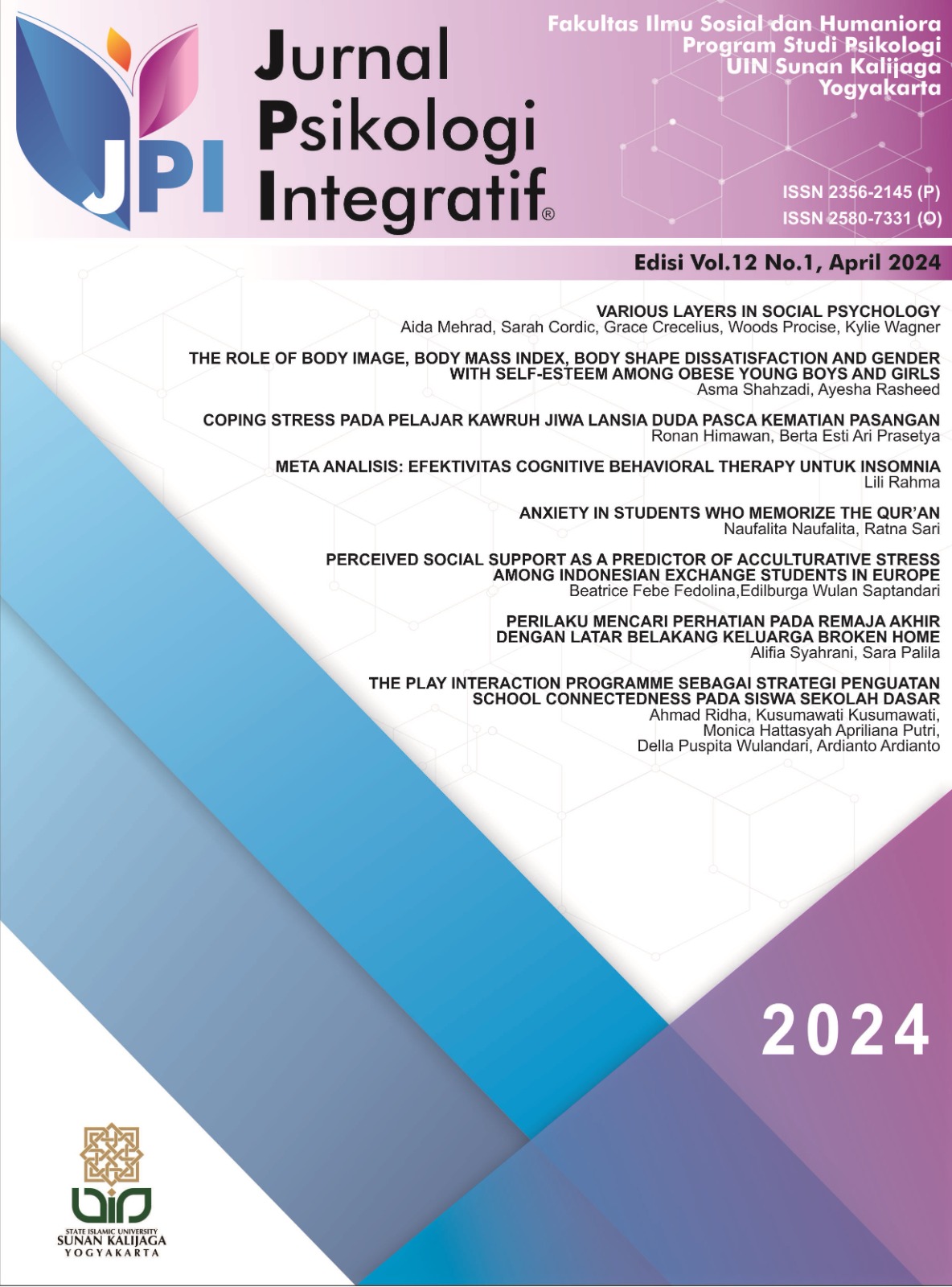Perilaku Mencari Perhatian pada Remaja Akhir dengan Latar Belakang Keluarga Broken Home
DOI:
https://doi.org/10.14421/jpsi.v11i1.3064Keywords:
Attention Seeking, Broken Home, Remaja AkhirAbstract
Tantangan yang berbeda dihadapi oleh remaja yang hidup dalam keluarga bermasalah yang sering disebut dengan keluarga broken home. Satu di antaranya adalah bagaimana mereka cenderung lebih banyak mencari perhatian dari orang sekitar. Tujuan penelitian ini adalah ingin melihat bagaimana gambaran perilaku mencari perhatian pada remaja yang berada dalam keluarga broken home. Penelitian ini menggunakan metode kualitatif dengan pendekatan fenomenologi. Data dikumpulkan melalui teknik wawancara dan dokumentasi terhadap tiga orang informan dengan kondisi keluarga broken home yang berbeda. Penelitian memberikan hasil bahwa perilaku mencari perhatian pada informan beragam, baik yang bentuknya negatif seperti menyakiti diri maupun positif yang berwujud pada dorongan belajar dan berprestasi yang tinggi. Hal yang mungkin berpengaruh adalah bentuk broken home yang dialami, pengaruh lingkungan sekitar, maupun kondisi internal dari remaja itu sendiri. Hasil penelitian ini diharapkan dapat menjadi dasar untuk mengembangkan rancangan modul intervensi yang dapat membantu remaja yang hidup dari keluarga broken mengelola dorongan mencari perhatian agar termanifestasi dalam perilaku yang lebih adaptif.
Different challenges are faced by teenagers who live in problematic families which are often called broken homes. One of them is how they tend to seek more attention from the people around them. The aim of this research is to explore the attention-seeking behavior of teenagers in broken home. This research uses a qualitative method with a phenomenological approach. Data was collected through interview and documentation techniques from three informants with different broken home family conditions. The research showed that attention-seeking behavior of the informants varied, both in negative forms such as self–harm and positive ones in the form of encouragement for learning and high achievement. Factors that may have an influence are the form of broken home experienced, surrounding environment, and internal condition of the teenager theirself. It is hoped that the result of this research can be the basis for developing intervention designs that can help adolescents living from broken families manage the urge to seek attention thus it manifests in more adaptive behavior.
Downloads
References
Almanshur Fauzan , Ghony Djunaidi (2012). Metodologi Penelitian kualitatif, JogJakarta: Ar‐Ruzz Media
American Psychiatric Association. (2013). DSM-5 Diagnostic Classification. In
Diagnostic and Statistical Manual of Mental Disorders.
https://doi.org/10.1176/appi.books.9780890425596.x00diagnosticclassification
Adristi, S. P. (2021). Peran Orang Tua pada Anak dari Latar Belakang Keluarga Broken Home. 1(2).
Amalia, & Rositawati, S. (2020). Studi Deskriptif Self-Compassion Anak yang Orangtuanya Bercerai Saat Remaja pada Anggota Komunitas Broken Home Bandung. Jurnal Psikologi, 6(1), 52–56.
Baskoro, A.K. 2008. Hubungan Antara Persepsi Terhadap Perceraian Orang Tua Dengan Optimisme Masa Depan Pada Remaja Korban Perceraian. Surakarta : Universitas Muhammadiyah
Cholid, N. (2021). Pengaruh Broken Home terhadap Anak. 6(1), 1–14.
Darmawant, R. R. (2023). Pola Asuh Orangtua Dalam Membentuk Karakter Anak. Jurnal Elementary, 2(2), 72–82.
Ermayani, N., Nurhasela, N., & Marleni, L. (2021). Analisis Perbedaan Belajar Terhadap Siswa yang Berasal Dari Keluarga Broken Home. Jurnal Pendidikan Dan Konseling (JPDK), 3(1), 110–116.
https://doi.org/10.31004/jpdk.v3i1.1446
Grossman, T. M. and S., Millon, C., Meagher, S., & Ramnath, R. (2007). Personality Disorders in Modern Life Second Edition. 1–627.
Hastuti, I. B., & Kirana, D. (2021). Kesejahteraan Psikologis Pada Individu Yang Mengalami Broken Home. JIKI Vol 14 No.2.
Herawati, T., Pranaji, D. K., Pujihasvuty, R., & Latifah, E. W. (2020). Faktor-Faktor yang Memengaruhi Pelaksanaan Fungsi Keluarga di Indonesia. Jurnal Ilmu Keluarga Dan Konsumen, 13(3), 213–227. https://doi.org/10.24156/jikk.2020.13.3.213
Hurlock E.B. (2000). Psikologi Perkembangan : Suatu Pendekatan Sepanjang Rentang Kehidupan. Jakarta : Erlangga.
Karimah, K. (2021). Kesepian dan Kecenderungan Perilaku Menyakiti Diri Sendiri pada Remaja dari Keluarga Tidak Harmonis. Psikoborneo: Jurnal Ilmiah Psikologi, 9(2), 367. https://doi.org/10.30872/psikoborneo.v9i2.5978
Krisdayanti, V., & Maryani, N. (2021). Optimalisasi Peran Keluarga Dalam Pengembangan Psikologi Anak Era New Normal DI Desa Jaya Mekar Kota Sukabumi Jawa Barat. Educivilia: Jurnal Pengabdian Pada Masyarakat, 2(1),51.
https://doi.org/10.30997/ejpm.v2i1.3616
Kuhlenschmidt, S. L., & Layne, L. E. (1999). Strategies for dealing with difficult behavior. New Directions for Teaching and Learning, 1999(77), 45–57.
https://doi.org/10.1002/tl.7705
Latipun. (2019). Kesehatan Mental . Malang: UMM Press.
Mellor, N. (2012). Attention Seeking: A Practical Solution for the Classroom.
https://doi.org/10.4135/9781446214107
Mellor, N. (2020). Encyclopedia of Personality and Individual Differences.
Encyclopedia of Personality and Individual Differences.
https://doi.org/10.1007/978-3-319-28099-8
Rochaniningsih, N. S., & Rochaniningsih, N. S. (n.d.). The Impact Of The Sift Of Family Role And Function On Teenager's Deviant Behaviors. 59–71
Romas, M. Z. (2012). Self-Injury Remaja Ditinjuau Dari Konsep Dirinya.pdf. In Jurnal Psikologi (Vol. 8, Issue 1, pp. 40–51).
Soetjiningsih. 2010. Tumbuh Kembang Remaja dan Permasalahannya. Jakarta: CV Sagung Seto.
Sung, Y., Lee, J. A., Kim, E., & Choi, S. M. (2016). Why we post selfies: Understanding motivations for posting pictures of oneself. Personality and Individual Differences, 97, 260–265. https://doi.org/10.1016/j.paid.2016.03.032
Walsh, B. W. (2012). Treating self-injury, second edition: a practical guide. New York: The Guilford Press.
Wulandri, D., & Fauziah, N. (2019). Pengalaman Remaja Korban Broken Home (Studi Kualitatif Fenomenologis). Empati, 8(1), 1–9.
Downloads
Published
Issue
Section
License
Copyright (c) 2024 Jurnal Psikologi Integratif

This work is licensed under a Creative Commons Attribution-NonCommercial-ShareAlike 4.0 International License.
Authors who publish with this journal agree to the following terms:- Authors retain copyright and grant the journal right of first publication with the work simultaneously licensed under a Creative Commons Attribution License that allows others to share the work with an acknowledgement of the work's authorship and initial publication in this journal.
- Authors are able to enter into separate, additional contractual arrangements for the non-exclusive distribution of the journal's published version of the work (e.g., post it to an institutional repository or publish it in a book), with an acknowledgement of its initial publication in this journal.
- Authors are permitted and encouraged to post their work online (e.g., in institutional repositories or on their website) prior to and during the submission process, as it can lead to productive exchanges, as well as earlier and greater citation of published work (See The Effect of Open Access).


.png)












